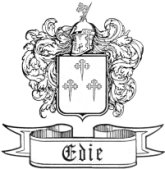A Sojourn in Australia
The 19-year old couple "...were married at St. Anne’s Church, Dunfermline, Fifeshire on 14th July 1854, and left Scotland for New South Wales on the 15th of November of the same year by the ship Anna, which sailed from Liverpool, and arrived in Sydney on February 21st 1855. Remaining in New South Wales till the following year ...they arrived in Bendigo in February 1856." Because the young couple would have been impoverished and there is a full calendar year before setting out for Bendigo, it would seem to suggest that their passage may have been paid, and they worked under bond in New South Wales.
This conjecture may be supported by the fact that this was the manner that Margaret Shepherd travelled to New Zealand in 1861. They may have then taken advantage of the new Bendigo diggings to seek their fortune.
The new society they encountered was one that had its detractors. Chambers’ Journal condemned New South Wales. "The emigrant who settles in these distant countries generally bids adieu to comfort and peace of mind." This presumes of course that they had these qualities in the first place! Another criticism dealt with the lawlessness which was perceived to be a result of the convicts.
"Robbery, violence, and indolence, stalk the land. That portion of the free labourers who had the means to leave have already done so; those who cannot get away are obliged to compete with the convicts, and thus earn a miserable subsistence in this...degraded colony"
However to John and Mary this was the opportunity which they had travelled so far to encounter; the chance to earn a good living without the tyranny of mine bosses. Their experience of a tough communal life in Dunfermline would have proved worthwhile, for the diggings teemed with others also working for their find.
Bendigo was a curious settlement, with hastily built tents comprising its dwellings. In 1853 Mrs. Ellen Clancy observed "Almost every tent has its large fire-place and chimney, constructed of logs, at one end of it; and there are many with an additional log-hut." She goes on to describe her own tent and the fence designed ..."to keep off wandering horses, and wandering drunkards in the night; both of which species of beasts are apt to stumble up against your tent lines, and threaten the demolition of the whole concern." Horses and drunkards were not the only plague; mice were a great nuisance:
"they swarm...and we find it one of the most difficult things in the world to catch them...(at night they were) running over my hands and face, and waking me!"
It was at Bendigo that the friendship with William Duff was established which developed into a partnership which weathered the passing of time and eventual emigration to New Zealand. William had arrived in Bendigo six years earlier to join his sister, Mary, and his brother-in-law Charles Sinclair. William and Mary were born in Surrey, England, and William had worked for an auctioneer before emigrating. Mary Sinclair also would have been company for Mary Edie, the ‘new chum’ at the diggings. The Sinclairs were also to be firm family friends for generations to come.
John Edie Jnr was born in 1856. Whether he was born before arriving at the camp is uncertain. A further two children were born there: Janet and Mary-Anne. However their stay at Bendigo was only to be for six years before a new frontier presented itself.
I suspect that he had learnt the lesson at the Bendigo diggings, that the suppliers made a regular income, as well as being in a good position to investigate good sites for a prospecting claim. John had success with his mining in Bendigo, but was wanting to see what the new goldrush in Otago offered. They had enough money by November 1862 for John to travel to Otago with a team of horses to start carrying between the Dunstan goldfield and Dunedin.
